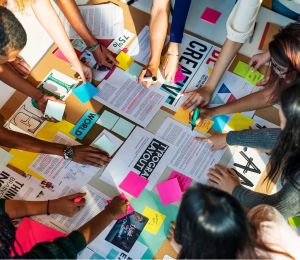Negative stereotypes: an analysis of social cognition in different ethnic groups. Social cognition of stereotypes
Estereotipos negativos: un análisis de la cognición social en diferentes grupos étnicos. Cognición social de los estereotipos
DOI:
https://doi.org/10.17081/psico.22.42.3501Palabras clave:
negative stereotypes, ethnicity, intergroup threat, Brazil, Poland., social cognitionResumen
Introduction: The processes related to social cognitions contribute as a traumatic and stressful event for some ethnic and minority groups, causing a series of psychic suffering in individuals. Social cognition considered stereotypes as characteristics of a group included in its mental representation.
Objective: The study was conducted to analyze the negative stereotypes in two cultures with very different history and geopolitical context, especially how stereotypes are reflected in the cognitive component of prejudiced attitudes.
Method: Four hundred fifty one (N=451) undergraduate students volunteered to take part in the study, the participants came from careers in the area of Social Sciences and Humanities in the non-probabilistic sample. After receiving the information, participants completed Negative Stereotype Index. A descriptive analysis and the T-test to know the differences between the perception and self-perception of the groups.
Results: Show that negative stereotype traits in Poland and Brazil, found negative stereotypic traits attributed to an out-group resulted in more unfavorable evaluations than descriptions consisting of positive attributes. In both groups, and their antecedents were associated with negative out-group attitudes, however, is a more general and more important one.
Conclusion: The findings found that expectations about the out group and negative stereotypes occur in conjunction with other negative emotions, which intensify negative out-group attitudes. The assessment that the Poles made of the Germans was like that of the Brazilians of the Argentines or of a group of relatively higher status. That is, they considered the Germans as more arrogant, sincere and less modest. The different groups of people may dislike each other for similar reasons. Explanations are offered for the limitations of the study and proposal for future research.
Descargas
Citas
Alesina, A., Carlana, M., Ferrara, E., & Pinotti, P. (December, 2018). Revealing Stereotypes: Evidence from Immigrants in Schools. Working Paper 25333. http://www.nber.org/papers/w25333
Branscombe, N. R., Schmitt, M. T., & Harvey, R. D. (1999). Perceiving pervasive discrimination among African Americans: Implications for group identification and well-being. Journal of Personality and Social Psychology, 77, 135-149. http://dx.doi.org/10.1037/0022-3514.77.1.135
Brewer, M. B., & Alexander, M. G. (2002). Intergroup emotions and images. In D. Mackie & E. Smith (Eds.), From prejudice to intergroup emotions: Differentiated reactions to social groups (pp. 209-225). New York: Psychology Press.
Cross, J. E. Jr. (1991). Shades of black: Diversity in African-American identity. Philadelphia: Temple University Press.
Cuddy, A. J. C. & Fiske, S. T. (2003). Behavioral correlates of warmth and competence stereotypes. Póster presentado en la cuarta reunión anual de la “Society for Personality and Social Psychology”, Los Angeles.
Dixon, T. L. (2000). A social cognitive approach to studying racial stereotyping in the mass media. African American Research Perspectives, 6(1), 60-68. https://babel.hathitrust.org/cgi/pt?id=mdp.39015042778095;view=2up;seq=66;size=150
Dovidio, J. F., Brigham, J., Johnson, B. T., & Gaertner, S. L. (1996). Stereotyping, prejudice, and discrimination: Another look. In N. Macrae, C. Stangor, & M. Hewstone (Eds.), Stereotypes and stereotyping (pp. 276-319). New York: Guilford.
Fiske, T. S. & Tablante, C. B. (2015). Attitudes and Social Cognition. In M. Mikulincer & P. R. Shaver (Editors-in-Chief), APA Handbook of Personality and Social Psychology. (Vol. 1, pp. 457-507). http://dx.doi.org/10.1037/14341-015
Fiske, S., & Taylor, S.E. (2013). Social Cognition: From brain to culture. 2th Ed. California: Sage.
Fiske, S. T., Cuddy, A. J. C., Glick, P., & Xu, J. (2002). A model of (often mixed) stereotype content: Competence and warmth respectively follow from perceived status and competition. Journal of Personality and Social Psychology, 82, 878-902. http://dx.doi.org/10.1037/0022-3514.82.6.878
Hadarics, M. & Kende, A. (2018). Negative stereotypes as motivated justifications for moral exclusion. The Journal of Social Psychology, 159(3) 257-269. https://doi.org/10.1080/00224545.2018.1456396
Hamilton, D. L., Sherman, S. J., & Ruvolo, C. M. (1990). Stereotype-based expectancies: Effects on information processing and social behavior. Journal of Social Issues, 46, 35-60. https://doi.org/10.1111/j.1540-4560.1990.tb01922.x
Kim, C., Harwood, J., & Xiang, J. (2018). The Negative and Positive influences of threat and nonthreat media messages about immigrants. International Journal of Communication, 12, 950-972. https://ijoc.org/index.php/ijoc/article/view/7284/2278
Koenig, A.M., & Eagly, A. H. (2005). Stereotype threat in man on a test of social sensitivity. Sex Roles, 52, 489-496. https://doi.org/10.1007/s11199-005-3714-x
Mathew, B., & Raja, B. W. D. (2018). Social Cogniton. New Delhi: S.B. Nangia A.P.H. Publishing Corporation.
Niwa, E. Y., Boxer, P., Dubow, E.F., Huesmann, L. R., Landau, S., Shikaki, K., & Gvirsman, S. D. (2014). Negative Stereotypes of Ethnic Out groups: A Longitudinal Examination Among Palestinian, Israeli Jewish, and Israeli Arab Youth. Journal of Research on Adolescence, 26(1), 166–179. https://doi.org/10.1111/jora.12180
Pahl, K., & Way, N. (2006). Longitudinal trajectories of ethnic identity among urban Black and Latino Adolescents. Child Development, 77(5), 1403-1415. https://doi.org/10.1111/j.1467-8624.2006.00943.x
Phinney, J. S. (1990). Ethnic identity in adolescents and adults. Review of research. Psychological Bulletin, 108, 499-514. http://dx.doi.org/10.1037/0033-2909.108.3.499
Ramos-Oliveira, D., Magnavita, P., & Oliveira, F. S. (2017). Aspectos sociocognitivos como eventos estressantes na saúde mental em grupos étnicos e minoritários no Brasil. Summa Psicológica UST, 14(1), 43-55. https://doi.org/10.18774/448x.2017.14.315
Riek, B. M., Mania, E. W., & Gaertner, S. L. (2006). Intergroup threat and outgroup attitudes: A Meta-Analytic Review. Personality and Social Psychology Review, 10, 336-353. https://doi.org/10.1207/s15327957pspr1004_4
Rotheram-Borus, M. J., Lightfoot, M., Moraes, A., Dopkins, S., & LaCour, J. (1998). Developmental, ethnic, and gender differences in ethnic identity among adolescents. Journal of Adolescent Research, 13, 487-507. https://doi.org/10.1177/0743554898134006
Schmitt, M. T., Spears, R., & Branscombe, N. R. (2003). Constructing a minority group identity out of shared rejection: The case of international students. European Journal of Social Psychology, 33, 1-12. https://doi.org/10.1002/ejsp.131
Smeding, A., Quinton, J-C., Lauer, K., Barca, L., & Pezzulo, G. (2016). Tracking and Simulating Dynamics of Implicit Stereotypes: A Situated Social Cognition Perspective. Journal of Personality and Social Psychology, 111(6), 817-834. http://dx.doi.org/10.1037/pspa0000063
Spencer-Rodgers, J. & McGovern, T. (2002). Attitudes toward the culturally different: The role of intercultural communication barriers, affective responses, consensual stereotypes, and perceived threat. International Journal of Intercultural Relations, 26, 609-631. https://doi.org/10.1016/S01471767(02)00038-X
Steele, C. M., & Aronson, J. (1995). Stereotype threat and the intellectual test performance of African Americans. Journal of Personality and Social Psychology, 69, 797-811. http://dx.doi.org/10.1037/00223514.69.5.797
Steele, C. M., Spencer, S. J., & Aronson, J. (2002). Contending with group image: The psychology of stereotype and social identity threat. In M. Zanna (Ed.), Advances in experimental social psychology (Vol. 34, pp. 379-440). New York: Academic Press.
Stephan, W. G., & Stephan, C. W. (1996). Predicting prejudice. International Journal of Intercultural Relations, 20, 409-426. http://dx.doi.org/10.1016/0147-1767(96)00026-0
Stephan, W. G., Boniecki, K. A., Ybarra, O., Bettencourt, A., Ervin,K. S., Jackson, L. A., McNatt P.S , and Renfro. C. L. (2002). The role of threats in the racial attitudes of Blacks and Whites. Personality and Social Psychology Bulletin, 28, 1242-1254. https://doi.org/10.1177/01461672022812009
Stephan, W. G., Renfro, C. L., Esses, V. M., Stephan, C. W., & Martin, T. (2001). The effect of threat on attitudes toward immigrants. Unpublished manuscript. New Mexico State University, Las Cruces, NM.
Wheeler, S. C., & Petty, R. E. (2001). The effects of stereotype activation on behavior: A review of possible mechanisms. Psychological Bulletin, 127, 797-826. http://dx.doi.org/10.1037/0033-2909.127.6.797
Ybarra, O., Schaberg, L., & Keiper, S. (1999). Favorable and unfavorable target expectancies and social information processing. Journal of Personality and Social Psychology, 77, 698-709. http://dx.doi.org/10.1037/0022-3514.77.4.698
Publicado
Cómo citar
Número
Sección
Licencia
Derechos de autor 2019 Diana Ramos-Oliveira, Andrzej Pankalla

Esta obra está bajo una licencia internacional Creative Commons Atribución 4.0.
Desde la revista Psicogente impartimos una política de respeto con nuestra comunidad científica incluyendo a nuestros autores. Los autores tienen derecho a un trato respetuoso y atento en el proceso Editorial, que las evaluaciones de sus artículos sean justas, imparciales (para ello la revista procederá con la evaluación doble ciego) y se realicen en un tiempo razonable. Se deberá mantener la confidencialidad y los permisos para proceder con la publicación. Todo cambio solicitado por parte del comité, los pares y el Editor deberán ser explícitos y claramente justificados. Especifica que los autores/as conservarán sus derechos de autor y garantizarán a la revista el derecho de primera publicación de su obra, el cual estará simultáneamente sujeto a la Licencia de reconocimiento de Creative Commons BY que permite a terceros compartir la obra siempre que se indique su autor y su primera publicación a esta revista.
Garantizamos un proceso editorial transparente: desde las acciones de recepción del articulo hasta la validación final del mismo, se hará en comunicación constante con el autor. Las modificaciones en el estado de los artículos, así como las diversas decisiones tomadas sobre él y los tiempos de ejecución empleados se realizarán haciendo uso de la plataforma OJS y de ser necesario en contacto directo a través del correo de autores y de la revista Psicogente. Así mismo se procura la escogencia de Pares revisores idóneos: con perfiles y experiencia que lleven a una avaluación de calidad de cada documento sometido a revisión.






